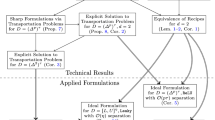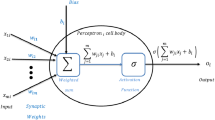Abstract
Deep Neural Networks (DNNs) are very popular these days, and are the subject of a very intense investigation. A DNN is made up of layers of internal units (or neurons), each of which computes an affine combination of the output of the units in the previous layer, applies a nonlinear operator, and outputs the corresponding value (also known as activation). A commonly-used nonlinear operator is the so-called rectified linear unit (ReLU), whose output is just the maximum between its input value and zero. In this (and other similar cases like max pooling, where the max operation involves more than one input value), for fixed parameters one can model the DNN as a 0-1 Mixed Integer Linear Program (0-1 MILP) where the continuous variables correspond to the output values of each unit, and a binary variable is associated with each ReLU to model its yes/no nature. In this paper we discuss the peculiarity of this kind of 0-1 MILP models, and describe an effective bound-tightening technique intended to ease its solution. We also present possible applications of the 0-1 MILP model arising in feature visualization and in the construction of adversarial examples. Computational results are reported, aimed at investigating (on small DNNs) the computational performance of a state-of-the-art MILP solver when applied to a known test case, namely, hand-written digit recognition.




Similar content being viewed by others
Explore related subjects
Discover the latest articles, news and stories from top researchers in related subjects.References
Belotti, P., Bonami, P., Fischetti, M., Lodi, A., Monaci, M., Nogales-Gomez, A., Salvagnin, D. (2016). On handling indicator constraints in mixed integer programming. Computational Optimization and Applications, 65, 545–566.
Cheng, C.-H., Nührenberg, G., Ruess, H. (2017). Maximum resilience of artificial neural networks. In D’Souza, D., & Narayan Kumar, K. (Eds.) Automated technology for verification and analysis (pp. 251–268). Cham: Springer International Publishing.
Le Cun, Y.L., Bottou, L., Bengio, Y., Haffner, P. (1998). Gradient-based learning applied to document recognition. Proceedings of IEEE, 86(11), 2278–2324.
Erhan, D., Bengio, Y, Courville, A., Vincent, P. (2009). Visualizing higher-layer features of a deep network.
Fischetti, M. (2016). Fast training of support vector machines with Gaussian kernel. Discrete Optimization, 22(Part A), 183–194. SI:ISCO 2014.
Fischetti, M., & Lodi, A. (2003). Local branching. Mathematical Programming, 98(1-3), 23–47.
Fischetti, M., & Monaci, M. (2014). Proximity search for 0-1 mixed-integer convex programming. Journal of Heuristics, 20(6), 709–731.
Goodfellow, I, Bengio, Y, Courville, A. (2016). Deep Learning. MIT Press. http://www.deeplearningbook.org.
ILOG IBM. Cplex 12.7 user’s manual (2017).
Krizhevsky, A., Sutskever, I., Hinton, G.E. (2017). Imagenet classification with deep convolutional neural networks. Communication of ACM, 60(6), 84–90.
Nair, V., & Hinton, G.E. (2010). Rectified linear units improve restricted Boltzmann machines. In Fürnkranz, J, & Joachims, T (Eds.) Proceedings of the 27th International Conference on Machine Learning (ICML-10) (pp. 807–814): Omnipress.
Rothberg, E. (2007). An evolutionary algorithm for polishing mixed integer programming solutions. INFORMS Journal on Computing, 19(4), 534–541.
Serra, T., Tjandraatmadja, C., Ramalingam, S. (2017). Bounding and counting linear regions of deep neural networks. CoRR arXiv:1711.02114.
Szegedy, C., Zaremba, W., Sutskever, I., Bruna, J., Erhan, D., Goodfellow, I.J., Fergus, R. (2013). Intriguing properties of neural networks. CoRR arXiv:1312.6199.
Tjeng, V., & Tedrake, R. (2017). Verifying neural networks with mixed integer programming. CoRR arXiv:1711.07356.
Acknowledgements
The research of the first author was partially funded by the Vienna Science and Technology Fund (WWTF) through project ICT15-014, any by MiUR, Italy, through project PRIN2015 “Nonlinear and Combinatorial Aspects of Complex Networks”. The research of the second author was funded by the Institute for Data Valorization (IVADO), Montreal. We thank Yoshua Bengio and Andrea Lodi for helpful discussions.
Author information
Authors and Affiliations
Corresponding author
Additional information
This article belongs to the Topical Collection: Integration of Constraint Programming, Artificial Intelligence, and Operations Research
Guest Editor: Willem-Jan van Hoeve
Rights and permissions
About this article
Cite this article
Fischetti, M., Jo, J. Deep neural networks and mixed integer linear optimization. Constraints 23, 296–309 (2018). https://doi.org/10.1007/s10601-018-9285-6
Published:
Issue Date:
DOI: https://doi.org/10.1007/s10601-018-9285-6




